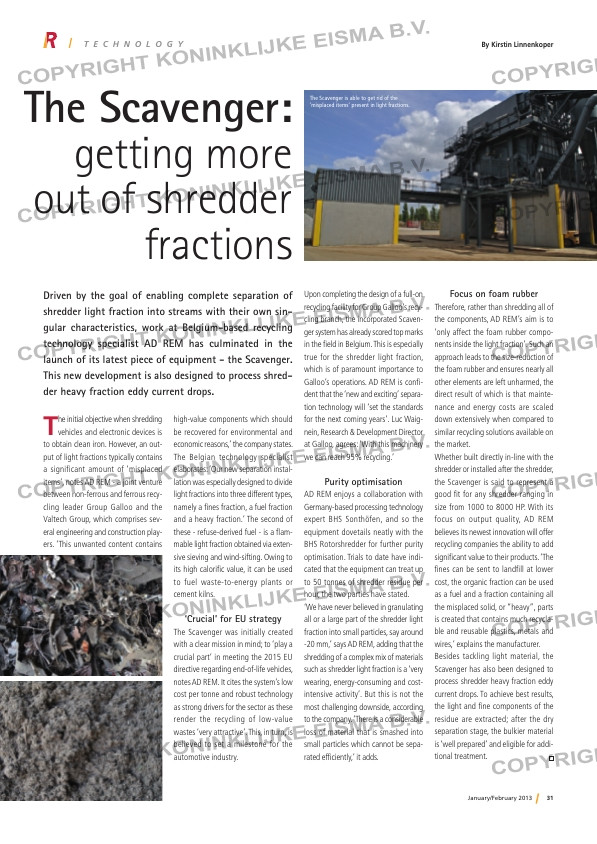Page 31 from: January / February 2013

31January/February 2013
The Scavenger:
getting more
out of shredder
fractions
Driven by the goal of enabling complete separation of
shredder light fraction into streams with their own sin-
gular characteristics, work at Belgium-based recycling
technology specialist AD REM has culminated in the
launch of its latest piece of equipment – the Scavenger.
This new development is also designed to process shred-
der heavy fraction eddy current drops.
The initial objective when shredding vehicles and electronic devices is
to obtain clean iron. However, an out-
put of light fractions typically contains
a significant amount of ‘misplaced
items’, notes AD REM – a joint venture
between non-ferrous and ferrous recy-
cling leader Group Galloo and the
Valtech Group, which comprises sev-
eral engineering and construction play-
ers. ‘This unwanted content contains
high-value components which should
be recovered for environmental and
economic reasons,’ the company states.
The Belgian technology specialist
elaborates: ‘Our new separation instal-
lation was especially designed to divide
light fractions into three different types,
namely a fines fraction, a fuel fraction
and a heavy fraction.’ The second of
these – refuse-derived fuel – is a flam-
mable light fraction obtained via exten-
sive sieving and wind-sifting. Owing to
its high calorific value, it can be used
to fuel waste-to-energy plants or
cement kilns.
‘Crucial’ for EU strategy
The Scavenger was initially created
with a clear mission in mind; to ‘play a
crucial part’ in meeting the 2015 EU
directive regarding end-of-life vehicles,
notes AD REM. It cites the system’s low
cost per tonne and robust technology
as strong drivers for the sector as these
render the recycling of low-value
wastes ‘very attractive’. This, in turn, is
believed to set a milestone for the
automotive industry.
Upon completing the design of a full-on
recycling facility for Group Galloo’s recy-
cling branch, the incorporated Scaven-
ger system has already scored top marks
in the field in Belgium. This is especially
true for the shredder light fraction,
which is of paramount importance to
Galloo’s operations. AD REM is confi-
dent that the ‘new and exciting’ separa-
tion technology will ‘set the standards
for the next coming years’. Luc Waig-
nein, Research & Development Director
at Galloo, agrees: ‘With this machinery
we can reach 95% recycling.’
Purity optimisation
AD REM enjoys a collaboration with
Germany-based processing technology
expert BHS Sonthöfen, and so the
equipment dovetails neatly with the
BHS Rotorshredder for further purity
optimisation. Trials to date have indi-
cated that the equipment can treat up
to 50 tonnes of shredder residue per
hour, the two parties have stated.
‘We have never believed in granulating
all or a large part of the shredder light
fraction into small particles, say around
-20 mm,’ says AD REM, adding that the
shredding of a complex mix of materials
such as shredder light fraction is a ‘very
wearing, energy-consuming and cost-
intensive activity’. But this is not the
most challenging downside, according
to the company. ‘There is a considerable
loss of material that is smashed into
small particles which cannot be sepa-
rated efficiently,’ it adds.
Focus on foam rubber
Therefore, rather than shredding all of
the components, AD REM’s aim is to
‘only affect the foam rubber compo-
nents inside the light fraction’. Such an
approach leads to the size-reduction of
the foam rubber and ensures nearly all
other elements are left unharmed, the
direct result of which is that mainte-
nance and energy costs are scaled
down extensively when compared to
similar recycling solutions available on
the market.
Whether built directly in-line with the
shredder or installed after the shredder,
the Scavenger is said to represent a
good fit for any shredder ranging in
size from 1000 to 8000 HP. With its
focus on output quality, AD REM
believes its newest innovation will offer
recycling companies the ability to add
significant value to their products. ‘The
fines can be sent to landfill at lower
cost, the organic fraction can be used
as a fuel and a fraction containing all
the misplaced solid, or “heavy”, parts
is created that contains much recycla-
ble and reusable plastics, metals and
wires,’ explains the manufacturer.
Besides tackling light material, the
Scavenger has also been designed to
process shredder heavy fraction eddy
current drops. To achieve best results,
the light and fine components of the
residue are extracted; after the dry
separation stage, the bulkier material
is ‘well prepared’ and eligible for addi-
tional treatment.
T e c h n o l o g y By Kirstin Linnenkoper
The Scavenger is able to get rid of the
‘misplaced items’ present in light fractions.
RI_1-Scavenger.indd 31 29-01-13 14:38



